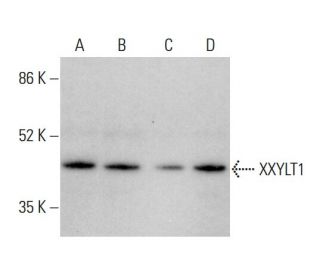
XXYLT1 Anticuerpo (G-7): sc-393607
- XXYLT1 Anticuerpo G-7 es un monoclonal de ratón IgM (kappa light chain) XXYLT1 Anticuerpo proporcionado como 200 µg/ml
- específico para un epítopo localizado entre los amino ácidos 259-288 de la región interna de XXYLT1 de origen human
- recomendado para detectar XXYLT1 of human origin, AI480653 of mouse origin and the corresponding rat homolog medainte WB, IP, IF, IHC(P) y ELISA
- Actualmente, aún no hemos completado la identificación de los reactivos de detección secundaria preferidos para XXYLT1 Anticuerpo (G-7). Este trabajo está en progreso.
ENLACES RÁPIDOS
VER TAMBIÉN ....
El anticuerpo XXYLT1 (G-7) es un anticuerpo monoclonal IgM κ de ratón XXYLT1 (también designado anticuerpo XXYLT1) que detecta la proteína XXYLT1 de origen humano, la proteína AI480653 de origen de ratón y el homólogo de rata correspondiente por WB, IP, IF, IHC(P) y ELISA. El anticuerpo XXYLT1 (G-7) está disponible como anticuerpo anti-XXYLT1 no conjugado. C3orf21 (chromosome 3 open reading frame 21), también conocida como FLJ35155, es una proteína de membrana de paso único de 393 aminoácidos que existe como tres isoformas empalmadas alternativamente. El C3orf21 está codificado por un gen que se localiza en el cromosoma humano 3q29. El cromosoma 3 está formado por aproximadamente 214 millones de bases que codifican más de 1.100 genes. En particular, en el cromosoma 3 hay un grupo de genes receptores de quimiocinas y diversos loci relacionados con el cáncer humano. Determinadas regiones del brazo corto del cromosoma 3 se suprimen en muchos tipos de células cancerosas. Los principales genes supresores de tumores del cromosoma 3 codifican el mediador de la apoptosis RASSF1, el regulador de la migración celular HYAL1 y el supresor de la angiogénesis SEMA3B. El síndrome de Marfan, la porfiria, el síndrome de von Hippel-Lindau, la osteogénesis imperfecta y la enfermedad de Charcot-Marie-Tooth son algunas de las numerosas enfermedades genéticas asociadas al cromosoma 3.
Alexa Fluor® es una marca registrada de Molecular Probes Inc., OR., USA
REIVEW LI-COR® y Odyssey® son marcas registradas de LI-COR Biosciences.
XXYLT1 Anticuerpo (G-7) Referencias:
- Disección citogenética molecular de la evolución de los cromosomas humanos 3 y 21. | Müller, S., et al. 2000. Proc Natl Acad Sci U S A. 97: 206-11. PMID: 10618396
- [Nuevos genes supresores de tumores en puntos calientes del cromosoma 3 humano: nuevos métodos de identificación]. | Braga, EA., et al. 2003. Mol Biol (Mosk). 37: 194-211. PMID: 12723467
- Plasticidad del cromosoma 3 humano durante la evolución de los primates. | Tsend-Ayush, E., et al. 2004. Genomics. 83: 193-202. PMID: 14706448
- Estructura genómica y regiones paralogas del punto de ruptura de inversión que se produce entre el cromosoma humano 3p12.3 y el cromosoma 2 del orangután. | Yue, Y., et al. 2005. Cytogenet Genome Res. 108: 98-105. PMID: 15545721
- La citogenética comparada del cromosoma humano 3q21.3 revela un punto caliente para la recombinación ectópica en la evolución hominoide. | Yue, Y., et al. 2005. Genomics. 85: 36-47. PMID: 15607420
- Las regiones evolutivamente plásticas en 3p21.3 humano coinciden con los puntos de rotura tumorales identificados por la 'prueba de eliminación'. | Darai, E., et al. 2005. Genomics. 86: 1-12. PMID: 15913951
- Secuencia de ADN, anotación y análisis del cromosoma 3 humano. | Muzny, DM., et al. 2006. Nature. 440: 1194-8. PMID: 16641997
- Establecimiento y caracterización de dos líneas celulares de melanoma uveal derivadas de tumores con pérdida de un cromosoma 3. | Nareyeck, G., et al. 2006. Exp Eye Res. 83: 858-64. PMID: 16750193
Información sobre pedidos
| Nombre del producto | Número de catálogo | UNIDAD | Precio | CANTIDAD | Favoritos | |
XXYLT1 Anticuerpo (G-7) | sc-393607 | 200 µg/ml | $316.00 | |||
XXYLT1 (G-7) péptido neutralizante | sc-393607 P | 100 µg/0.5 ml | $68.00 |
